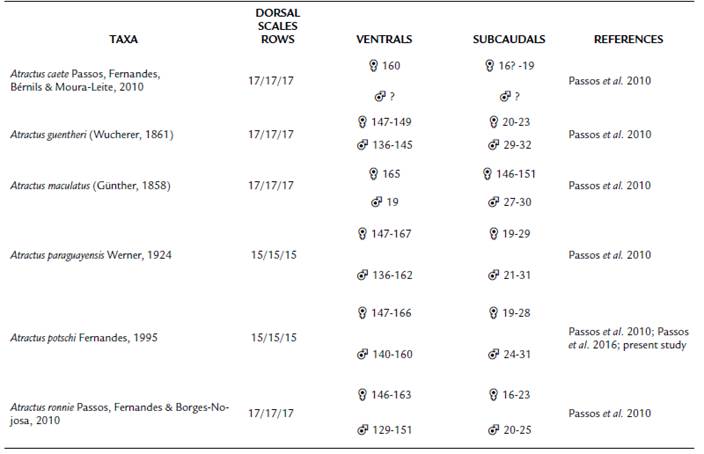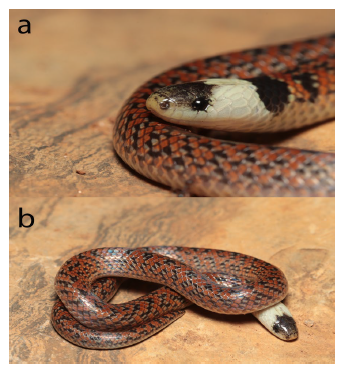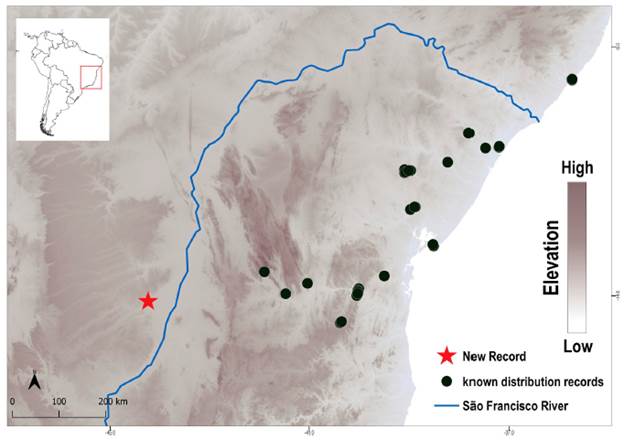Atractus Wagler 1828 is a highly diverse Dipsadid genus, with 143 valid species distributed throughout South America (Passos et al., 2010; Uetz et al., 2021). It consists of small to moderate sized snakes, with cryptozoic or semi-fossorial habits, that prey on invertebrates (Cunha and Nascimento, 1993; Martins and Oliveira, 1993; Passos et al., 2010; 2016a). Due to their secretive habits, several species of this genus have been found only in a few localities, and many of those are known only from type material (Passos and Fernandes, 2008; Prudente and Passos, 2008; Passos et al., 2010).
Atractus potschiFernandes, 1995, the species of the A. paraguayensis group with the Northernmost distribution in South America (Passos et al., 2013; Nogueira et al., 2019) was described based on 12 individuals from Alagoas and Sergipe, Brazil, with only one location record per state (Fernandes, 1995). Lima et al. (2000) extended its distribution to the State of Bahia, whereas Passos et al. (2010), in a checklist and revision of Atlantic Rain Forest Atractus species, presented five new records of A. potschi in Northeastern Brazil. More recently, Nogueira et al. (2019) provided new accounts on the distribution of A. potschi. Since the species' original description, most of its distribution records are on the right bank of the São Francisco River (SFR) (Nogueira et al., 2019). Herein we present a new record of A. potschi, and an updated distribution map, including a new locality on the left bank of the SFR.
During a field expedition in Feira da Mata, State of Bahia, Brazil (14°06'46.1" S, 44°14'22.2" W; 40 m a.s.l.), on 29 October 2020, we found an individual of Atractus under logs in the leaf litter, in a "mata de Caatinga" physiognomie, a semi-decidual forest habitat. The specimen was collected, euthanized with lidocaine (7 %) injection in its coelom, fixed with 10 % formalin, and stored in 70 % ethanol. The species was identified as A. potschi according to Fernandes (1995) and Passos et al. (2010, 2013, 2016a, 2016b), with the following diagnostic characters: 15/15/15 smooth dorsal scale rows, 147-166 ventral scales in females and 140-160 in males, 19-25 subcaudal scales in females and 24-31 in males, two postoculars, loreal long, temporals 1+2, six or seven supralabials, seven infralabials, venter immaculate white, dorsal coloration with black color and black dots, occasionally merging into blotches or crossbands, juveniles with white collar (Table 1). The specimen was deposited in the herpetology collection of Museu Paraense Emílio Goeldi (Voucher MPEG27250). The collection took place under license SISBIO 28190-2, granted by the Brazilian Institute for Biodiversity Conservation - ICMBio. We generated distribution maps using QGIS v. 2.18 software (QGIS Development Team 2018) and previous literature records (Fernandes, 1995; Lima et al., 2000; Passos et al., 2010; Nogueira et al., 2019).
Table 1 Pholidosis data for comparisons between Atractus potschi, Atractus species of the paraguayensis group and sympatric species following distribution maps provided by Nogueira et al. (2019).

The individual was a juvenile female A. potschi (Fig. 1a and 1b). The specimen has the following characteristics: 15/15/15 smooth dorsal scale rows; 157 ventral scales; 28 subcaudal scales; seven supralabials (third and fourth contacting the orbit); six infralabials; temporals 1+2; two postoculars; loreal long; the color pattern composed by transverse blotches forming crossbands, with two nuchal black collars and a white occipital band, venter immaculate cream white; 150 mm snout-vent length; 15 mm tail length; 8.6 mm head length; 3.5 mm head height; and 3.6 mm head width .

Figure 1 a. Detail of the head of the live specimen. b. Detail of the body, showing the coloration pattern and the tail of the live specimen.
Our distribution extension represents A. potschi's furthest inland record, placed 270 km from the nearest known occurrence, and across the SFR (Fig. 2). In addition to our record, there are only one other record on the left bank of the SFR, in Maceió, Alagoas state, 1061 km from our record (Fig. 2), and close to the São Francisco River mouth in the Atlantic Ocean.

Figure 2 Geographical distribution of Atractus potschi from northeastern Brazil. Black dots represent literature records, red star represent the new record.
Although our specimen presents a higher number of subcaudal scales (28) than the recorded range from the literature (19-25, Passos et al., 2016), small variations such as this one are expected with analysis from new individuals. In the revision of the Atlantic Forest species of Atractus made by Passos et al. (2010) the range found in 21 individuals of A. potschi was 153-165 ventrals scales in females, 141-150 in males, and 22-25 subcaudal scales in females, 27-32 in males. However, Passos et al. (2016), with the analysis of 90 individuals of A. potschi, increased the range of both ventral and subcaudal scales, with 147-166 ventral scales in females, 140-160 in males, and 19-25 ventral scales in females, 24-31 in males. Therefore, the variation within subcaudal scales in A. potschi females increases from 19-25 (Passos et al., 2016) to 19-28.















